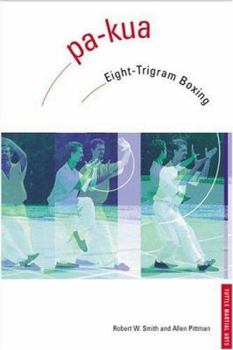Pa-Kua: Eight-Trigram Boxing
Select Format
Select Condition 
Book Overview
Originally published in 1967, Pa-Kua was the West's first look into the esoteric Chinese martial arts. It has been a valued and sought after text ever since. It was put out of print in the 1970's, but... This description may be from another edition of this product.
Format:Paperback
Language:English
ISBN:0804816182
ISBN13:9780804816182
Release Date:January 1994
Publisher:Tuttle Publishing
Length:99 Pages
Weight:0.50 lbs.
Dimensions:0.4" x 6.0" x 8.9"
Customer Reviews
5 ratings
the circular art of ba gua
Published by Thriftbooks.com User , 20 years ago
This book presents the first descriptions in English of bagua methods transmitted by Zhang Juen-feng to the Hung family of Taipei. The Hung school became renouned and feared for their fighting prowess, so I agree fully with the previous 5-star reviews. Although such forms are posited on a line, there are many spirals and circles inherent to the movements as well, and the system does include a related set of circle walking and circular changes passed down from Zhang. So bagua is circular - true enough - and the author takes things to that level, as exemplified in the circling method of Paul Guo (along with footnotes on Wang Shu-chin, another peerless fighter; just ask the Japanese who met him). Mr Guo was a municipal police officer, also skilled in xing-yi, whose bagua was based on that of Sun Lu-tang. The book does not provide details on the many fighting functions inherent to the circular changes for reasons of time and space and those given by the author himself (i.e., linear methods more easy to grasp for Westerners at the time). Think about it. Given his vast experience, it is unlikely that the author would take the time to learn and publish a method that was devoid of fighting applications. In fact, he showed many of them in his regular classes, and importantly, also taught principles on how to look for other applications. Times being what they are today, it should be no problem for the uninitiated and perplexed to find someone also skilled at the circling methods in order to lend a convincing hand. But first, give the book a fair shake, try some of the methods, and then go out and find a teacher to help you along. Respectfully, even if you are an undefeated mixed-martial arts champion, a thorough study of these practices will surely improve your skill level and definitely change your outlook on these arts.
The Best intro book on Pakua
Published by Thriftbooks.com User , 23 years ago
Robert Smith, in 94 pages, introduces us to philosophy, lineage, concepts and the internal power of bagua masters. There are no martial applications described in the book but there is an excellent presentation of a standard intermediate bagua form set. This type of set is usually done after learning to walk the circle with the eight mother palms. This book recommends walking the circle using the basic dragon palms. This book is an easy, economical way to begin an exploration of Pagua without being ovewhelmed. It should be in everyone's Pakua library.
Pa-Kua Chinese Boxing for Fitness and Self-Defense
Published by Thriftbooks.com User , 24 years ago
First published in 1967, this book was the first English-language text about Pa-Kua Chuan ("eight trigram boxing," also spelled Baguazhang), a comprehensive system of self-defense from China. It is one of the three nei-chia or "internal" systems of martial arts, the other two being Hsing-I Chuan and the more familiar T'ai-Chi Chuan. Mr. Smith, now retired, was a CIA analyst specializing in the Chinese economy and is also a leading scholar of Asian fighting arts. ["Asian Fighting Arts," which he co-authored with Donn Draeger, remains the single best comprehensive description of the entire range of Asian martial arts.] Mr. Smith moved to Taiwan with his wife Alice in the late 1950s to study the internal and external arts with their leading exponents, nearly all of whom had left China in 1949. [He relates many of his interesting experiences in another excellent book, "Chinese Boxing: Masters and Methods."] He was thus among the first Americans to study these arts with teachers who traced their lineages back to the teachers who codified them in the eighteenth and nineteenth centuries. This text presents much of the material Mr. Smith brought back from Taiwan, including a brief history of the art and an illustrated description of much of the art's basic material as taught by Mr. Smith's primary teachers, Hung I-hsiang and Kuo Feng-sh'ih. The material covered includes eighteen basic exercises, twenty of the sixty-four linear forms, and the basic circling exercises. The book is thus an indispensable aid for anyone undertaking a serious study of Pa Kua, and also a very interesting and useful text for anyone engaged in almost any kind of serious physical discipline.
Clear, concise presentation of one entire Pa Kua form.
Published by Thriftbooks.com User , 24 years ago
No-one has done as much to bring the Chinese internal arts into the awareness of Western martial artists as R.W. Smith.It is reassuring to see that his student, Allan Pittman apparently intends to continue this process.There is nothing superfluous in this book. Aside from basic guidelines of practice, the main focus is on one complete Pa Kua form.This form is demonstrated by Mr. Pittman and the photographs are of such clarity that anyone with a background in one or other movement or martial art should be able to learn from them.As any martial artist worth his salt knows, the basics are everything and the basic practice of Pa Kua is the circle walking, single palm change and the form. This book does an excellent job of illustrating these basics. The rest is up to the reader.
One of the best Pa Kua books around: 5 STARS!!!
Published by Thriftbooks.com User , 25 years ago
Clearly written, includes the history, basics; and a well described--complete--Pa Kua Chang solo exercise!




